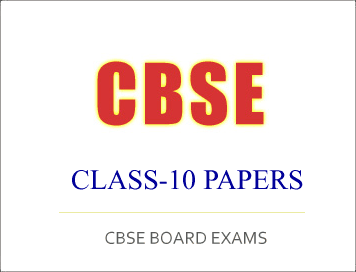CBSE PORTAL : CBSE Class-10 Exam 2018 : All India Scheme Question Paper-Front Office Operations | |
- CBSE Class-10 Exam 2018 : All India Scheme Question Paper-Front Office Operations
- CBSE Class-10 Exam 2018 : All India Scheme Question Paper-Karnatic Music
- (Download) CBSE: Class XII Taxation Question Paper - 2018
- (Download) CBSE: Class XII Knowledge Traditions and Practices of India Question Paper - 2018
| CBSE Class-10 Exam 2018 : All India Scheme Question Paper-Front Office Operations Posted: 27 Jul 2018 12:07 AM PDT |
| CBSE Class-10 Exam 2018 : All India Scheme Question Paper-Karnatic Music Posted: 26 Jul 2018 11:39 PM PDT |
| (Download) CBSE: Class XII Taxation Question Paper - 2018 Posted: 26 Jul 2018 10:57 PM PDT
Question Papers For Board Examinations 2018Class – XIISubject – TaxationSubject : Taxation Class : XII Year : 2018 General Instructions : (i) All questions are compulsory. Questions :1. X spent < 40,000 on medical treatment of his dependant brother, suffering from 50 percent disability. How much deduction can he claim under Section 80 DD ? 2. Who can claim deduction under Section 80 E ? 3. Name any one fund where 100% deduction is eligible under Section 80 G. 4. For the assessment year 2017 – 18, what is the rule for rebate under Section 87 A ? 5. Tax is to be deducted at source from winnings from lotteries or crossword puzzles if the amount of payment is more than < __________ . 6. State the importance of VAT. 7. Mention one situation when no input tax credit is available on purchases. 8. What do you mean by ‘declared goods’ under Central Sales Tax ? 9. Name two services in the negative list not chargeable to service tax. 10. X, a resident individual, spends < 30,000 on his medical treatment in a government hospital and < 14,000 on medical treatment of his dependant brother. Both are suffering from a specified disease as prescribed by the Board. Click Here To Download Full Paper<< Go Back To Main PageCourtesy: CBSE |
| (Download) CBSE: Class XII Knowledge Traditions and Practices of India Question Paper - 2018 Posted: 26 Jul 2018 10:10 PM PDT
Question Papers For Board Examinations 2018Class – XIISubject – Knowledge Traditions and Practices of IndiaSubject : Knowledge Traditions and Practices of India Class : XII Year : 2018 General Instructions :
Questions :SECTION A(Reading Skills)(a) Read the passage given below and answer the following questions : Vāstu-vidyā or Śilpaśāstra - the science of architecture- is one of the technical subjects studied in ancient India, along with Āyurveda (science of medicine), dhanurveda (science of archery), jyotisa (astronomy), etc. In the earliest texts, the word Vāstu occurs in the sense of a building site or the building itself. Later on, other subjects such as temple construction, town planning, public and private buildings and forts were included in the discipline in which the construction of a structure was regarded as a sacred act. In the Atharvaveda there are references to different parts of the building such as sitting-room, inner apartment, room for sacred fire, cattleshed and reception room (Atharvaveda, IX.3). The Sānkhāyana Grhya Sūtra (c. 500 BCE) describes in three chapters the ceremonials performed for constructing a building. Kautilya’s Arthaśāstra (c. 300 BCE) deals with town planning, fortifications and other structures of civil nature. Samarāngana Sūtradhāra, authored by King Bhoja (1010 -55 CE), discusses methods of examination of a site, analysis of the soil, systems of measurement, qualifications of the sthapati (architect) and his assistants, building materials, consecration of the plan followed by construction of foundation, basal mouldings and technical details for each part of the plan, design and elevation. The two principal south Indian texts, Mayamata (1000 CE) and Mānasāra (1300 CE), share a common perception of architectural plan and design of the southern (Drāvida) vintage but while the former has a practical outlook, the latter develops the theoretical side of the science. (i) Explain Vastu as explained in ancient texts. (b) Read the passage given below and answer the following questions : Miniature paintings are executed on books and albums, and on perishable material such as paper and cloth. The Palas of Bengal were the pioneers of miniature painting in India. The art of miniature painting reached its zenith during the Mughal period. The tradition of miniature paintings was continued by the painters of different Rajasthani schools of painting, like Bundi, Kishangarh, Jaipur, Marwar and Mewar. The Ragamala paintings also belong to this school, as do the Company paintings produced during the British Raj. Unfortunately, early miniatures in wood and cloth have been completely lost, the earliest extant belonging to the late 8th or mid 9th centuries of the Pala period in eastern India, are representations of Buddhist yantra, graphic symbols which were visual aids to the mantra and the Dharani. Conforming to the canons of iconography, these Buddhist miniatures deify Buddhist thought such as Prajñāpāramitā, who, as the mother of all the Buddhas, was the personification of esoteric knowledge. The Buddhist paintings were rawn in red and white, forming colour planes. The inspiration came from the metal images, giving an illusion of relief. Miniatures were painted according to the rules of mural painting, the rule of proportions being regulated by strict codes of measurement. Effects such as foreshortening were derived from the study of sculpture rather than from reality. (i) When and in which part of India did the miniature painting start ? Click Here To Download Full Paper<< Go Back To Main PageCourtesy: CBSE |
| You are subscribed to email updates from CBSE PORTAL : CBSE, ICSE, NIOS, JEE-MAIN, AIPMT Students Community. To stop receiving these emails, you may unsubscribe now. | Email delivery powered by Google |
| Google, 1600 Amphitheatre Parkway, Mountain View, CA 94043, United States | |


No comments:
Post a Comment